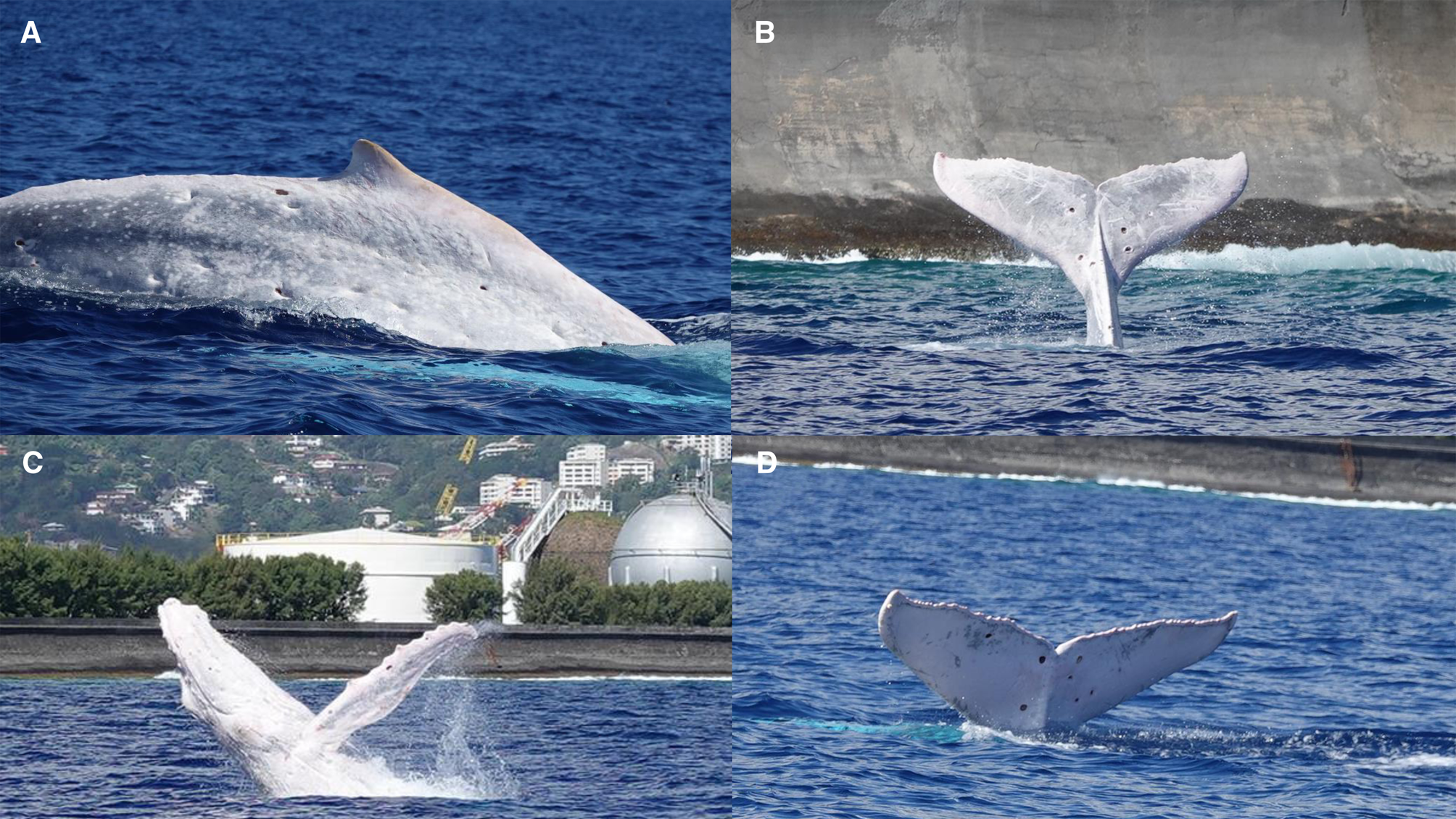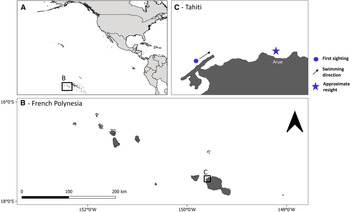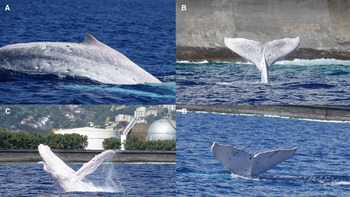Melanin production in mammals is regulated by the enzyme tyrosinase (Behrmann, Reference Behrmann1998). Melanocytes and chromatophore cells are responsible for the production of melanin, which results in the dark skin colour of cetaceans (Behrmann, Reference Behrmann1998). Albinism is characterized by the complete absence of melanin, and consequently, a lack of pigmentation in the skin, hair, and eyes (Grønskov et al., Reference Grønskov, Ek and Brondum-Nielsen2007). Leucism occurs when a lack of melanin partially affects skin pigmentation in some areas of the body, excluding the eyes (Fertl and Rosel, Reference Fertl, Rosel, William, Würsig and Thewissen2009). Piebaldism occurs when the lack of pigmentation in the skin is random, leading to the display of patchy patterns (Fertl and Rosel, Reference Fertl, Rosel, William, Würsig and Thewissen2009). Anomalous white colouration in marine mammals can negatively affect survival due to the increased visibility of predators (Hain and Leatherwood, Reference Hain and Leatherwood1982), and decreased protection from ultraviolet radiation and sun damage (Martinez-Levasseur et al., Reference Martinez-Levasseur, Gendron, Knell, O'Toole, Singh and Acevedo-Whitehouse2011). Anomalous white colouration in mammals can cause health problems, such as anaemia, reduced fertility, sensory system defects, and increased susceptibility to infections (Searle, Reference Searle1968); however, it is currently unclear whether these health problems affect marine mammals. Albinism and anomalous white colouration were recorded in approximately 25 cetacean species (Fertl and Rosel, Reference Fertl, Rosel, William, Würsig and Thewissen2009) including 17 odontocetes (e.g. killer whales [Speckman and Sheffield, Reference Speckman and Sheffield2001], pilot whales [Hain & Leatherwood, Reference Hain and Leatherwood1982], harbour porpoises [Tonay et al., Reference Tonay, Bilgin, Dede, Akkaya, Yeşilçiçek, Köse and Ceylan2012; Kopaliani et al., Reference Kopaliani, Gurielidze and Ninua2017], short-beaked dolphins [Kopaliani et al., Reference Kopaliani, Gurielidze and Ninua2017]), and eight mysticetes (e.g. grey whales [Willoughby et al., Reference Willoughby, Ferguson, Clarke and Brower2018], and humpback whales [Polanowski et al., Reference Polanowski, Robinson-Laverick, Paton and Jarman2012; Burns et al., Reference Burns, Brooks, Harrison, Franklin, Franklin, Paton and Clapham2014; Pirotta et al., Reference Pirotta, Franklin, Mansfield, Lowe and Peterson2023]).
The humpback whale, Megaptera novaeangliae, is a migratory species morphologically characterized by dark grey to black dorsal surface colour with dark or white ventral sides according to the population from which they originate. Northern Hemisphere humpback whales tend to be totally black, while the Southern Hemisphere humpback whales are mostly white in the ventral area (Chittleborough, Reference Chittleborough1965; Allen et al., Reference Allen, Rosenbaum, Katona, Clapham and Mattila1994; Acevedo et al., Reference Acevedo, Aguayo-Lobo, Allen, Botero-Acosta, Capella, Castro, Rosa, Denkinger, Félix, Flórez-González, Garita, Guzmán, Haase, Kaufman, Llano, Olavarría, Pacheco, Plana, Rasmussen, Scheidat, Secchi, Silva and Stevick2017). The variation in skin pigmentation is used for individual identification, which allows to assess migratory routes, movement patterns, and site fidelity (Forestell et al., Reference Forestell, Paton, Hodda and Kaufman2001; Lydersen et al., Reference Lydersen, Oien, Mikkelsen, Bober, Fisher and Kovacs2013; Pirotta et al., Reference Pirotta, Franklin, Mansfield, Lowe and Peterson2023). Southern Hemisphere humpback whale populations are divided into seven breeding stocks (A–G) according to the International Whaling Commission. Anomalous skin colour patterns (leucism) were previously reported in humpback whales in Ecuador (stock G, 2002, Castro et al., Reference Castro, Groch, Marcondes, Van Bressem and Van Waerebeek2007), in eastern Australia (stock E, 1991, Forestell et al., Reference Forestell, Paton, Hodda and Kaufman2001), in Norway (Cape Verde, 2012, Lydersen et al., Reference Lydersen, Oien, Mikkelsen, Bober, Fisher and Kovacs2013), and in South Africa (stock B, 2014, Koper et al., Reference Koper, Drost and Plön2017). Albinism was only confirmed genetically in the eastern Australia sighting (Forestell et al., Reference Forestell, Paton, Hodda and Kaufman2001; Polanowski et al., Reference Polanowski, Robinson-Laverick, Paton and Jarman2012). Two presumed cases of albinos were reported both in eastern Australia in 2011 (Koper et al., Reference Koper, Drost and Plön2017) and in Costa Rica in 2022 (Mora et al., Reference Mora, Lopez, Cruz and Chaves2022).
In this note, I report the first record of a humpback whale with anomalous skin pigmentation sighted opportunistically off the coast of Papeete, Tahiti, French Polynesia. Two opportunistic sightings were made on the same day (Figure 1A, B). On 25 July 2019, at 0930 am a white humpback whale was observed off Papeete (17°31′30.0″S, 149°34′34.9″W) during a private boat trip (Figure 1). Data were collected by a citizen (Montlahuc) during this trip and included photographs of the whale, geographic location, behaviour, and time of the sighting. Photographs were taken with a Sony DSC-Rx10M4 camera. The whale was re-sighted by divers about 5 km away in the early afternoon of the same day farther north near the commune of Arue (Montlahuc, pers. comm.) (Figure 1C). No coordinates were obtained from this resighting. The whale has not been resighted since 2019 by local nonprofits dedicated to whale research (Bennet, pers. comm.). It was impossible to determine the individual's size based on in situ observations. The individual was displaying surface-active behaviours such as breaching and tail slapped several times. The individual presented a mixed grey-white body colour with some skin lesions likely made by cookie shark (Isistius brasiliensis) bites (Figure 2A–D). The ventral surface of the flukes displayed some white-grey-coloured patterns (Figure 2D). Pink skin was also observed on the dorsal fin of the animal (Figure 2A). No photograph could be taken of the eyes to assess the presence of red eyes to characterize albinism. This report represents the first documented case of a leucistic white whale in the breeding stock F.

Figure 1. Location of French Polynesia (A, B) and the observation location in Papeete, Tahiti (C) with a black arrow indicating the track of the boat that followed the whale.

Figure 2. Photographs of an anomalous skin-coloured humpback whale observed in Papeete, Tahiti, on 25 July 2019 showing the dorsal surface of (A) the dorsal fin and (B) the dorsal side of the fluke; (C) the right side of the head and right pectoral flipper head and (D) the ventral side of the fluke with skin lesions likely made by cookie shark (I. brasiliensis) bites. Photo credit: Olivier Montlahuc.
Humpback whales observed in Oceania are part of breeding stock F, which ranges from the Cook Islands (substock F1) to French Polynesia (substock F2) (Pastene et al., Reference Pastene, Goto, Kanda, Kitakado and Palsboll2011). No other sighting of anomalous skin-coloured whales was previously reported in breeding stock F. Despite the disadvantages that white skin colours may present, two adult white whales are known to be at least 20 years old as reported off the Norwegian mainland coast (Lydersen et al., Reference Lydersen, Oien, Mikkelsen, Bober, Fisher and Kovacs2013) and eastern Australia (Pirotta et al., Reference Pirotta, Franklin, Mansfield, Lowe and Peterson2023). Except for those two whales, few photographic or visual recaptures of white whales were reported in the past. The atypical body colouration of the individual sighted off Tahiti can result in a higher likelihood to be resighted compared to normal skin colouration, especially if it occurs in coastal areas with high anthropogenic activity. No recaptures of this animal were made on the Happywhale citizen science platform containing a database of approximately 289,000 encounters and uses fully automated fluke-matching software (Cheeseman et al., Reference Cheeseman, Southerland, Park, Olio, Flynn, Calambokidis, Jones, Garrigue, Frisch, Howard, Reade, Neilson, Gabriele and Clapham2022).
Anomalous white colouration can be of genetic origin due to mutations in the tyrosinase enzyme, and albinism is the result of homozygous deletion of the nucleobase cytosine in DNA (Polanowski et al., Reference Polanowski, Robinson-Laverick, Paton and Jarman2012). In the Southern Hemisphere, the recessive allele responsible for depigmentation in humpback whales has been reported in stock E (eastern Australia; Forestell et al., Reference Forestell, Paton, Hodda and Kaufman2001) and potentially in stock G (Central to South America; Mora et al., Reference Mora, Lopez, Cruz and Chaves2022). It is unclear if this phenomenon is the result of a recessive allele transmission between stocks or if this results from an independent genetic anomality (e.g. insertions or deletions). Interchange has been found in the past between stocks E and F (Western Australia) through photo-identification methods (Garrigue et al., Reference Garrigue, Franklin, Constantine, Russell, Burns, Poole, Paton, Hauser, Oremus, Childerhouse, Mattila, Gibbs, Franklin, Robbins, Clapham and Baker2011). If the recessive allele responsible for albinism is present in stock F it might indicate potential inter-stock movements with stock E, where one albino was previously observed (Pirotta et al., Reference Pirotta, Franklin, Mansfield, Lowe and Peterson2023). Future resighting of anomalous white-coloured humpback whales should include biopsy sampling and genetic analysis of skin samples to understand the origin of the genetic deviation (e.g. gene mutation or allele transfer) to assess potential stock exchanges and reproduction.
Acknowledgements
I would like to thank Mathilde Giry for indicating the existence of this albino sighting and Olivier Montlahuc for sharing his observation, photographs, and related information. Special thanks to Marie Van Bressem for her input on the skin lesion analysis, PC and the two reviewers for revising this manuscript, and Agnes Bennet from Association Mata Tohora confirming the absence of recapture of this white humpback whale in the area. No permits were required for the data collection.
Financial support
This research received no specific grant from any funding agency, commercial, or not-for-profit sectors.
Competing interest
None.
Data availability
All the data are available upon request.




